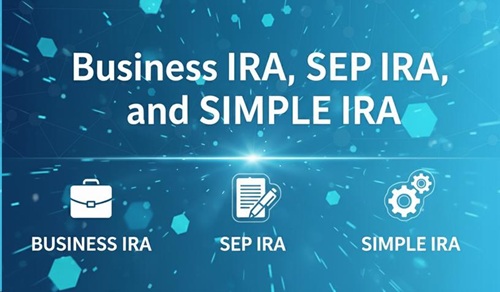Business IRA Retirement Account (IRAs): The Ultimate Guide for California Business Owners, Doctors & Dentists 🌴
Presented by: Sun Insurance & Financial
📞 Telephone: (310) 860-5000
Serving: Los Angeles | Beverly Hills | Santa Monica | Malibu | West Hollywood
🌟 Introduction
Business IRA Retirement Accounts: If you own a business in California—whether a dental practice in Beverly Hills, a law firm in Los Angeles, a tech startup in Santa Monica, or a real estate agency in Malibu—you’ve likely asked:
“What’s the smartest way to save for retirement while reducing taxes?”
The answer often lies in Business IRA Retirement Account (IRAs). These plans not only secure your future but also reduce your tax burden and help attract and retain top talent.
At Sun Insurance & Financial, we help California business owners design the most effective retirement strategies—from SEP IRA and SIMPLE IRA to Traditional IRA, Roth IRA, and even Backdoor Roth conversions.
This guide explains everything you need to know:
✅ What Business IRAs are
✅ How they work and what they cover
✅ Different types of Business IRAs
✅ Real-life scenarios and examples
✅ Common questions and answers
✅ How to contact Sun Insurance & Financial
🏦 What Is a Business IRA Retirement Account?

A Business IRA Retirement Account (Individual Retirement Account) is a retirement savings plan that allows small-business owners and self-employed professionals to save for retirement in a tax-advantaged way.
Think of it as your personal pension—but designed for entrepreneurs and professionals rather than large corporations.
💡 Why It Matters:
Unlike employees of large companies who enjoy 401(k) plans, business owners must create their own retirement safety nets. A Business IRA Retirement Accounts ensures:
-
Tax-deferred or tax-free growth
-
Significant annual contribution limits
-
Flexible control over investments
-
Protection for both the owner and employees
💰 What Does a Business IRA Retirement Account Cover?

A Business IRA Retirement Account covers long-term retirement savings, allowing funds to grow through investments such as:
-
Stocks 📈
-
Bonds 💵
-
Mutual Funds 💼
-
ETFs (Exchange-Traded Funds)
-
Real Estate Investment Trusts (REITs) 🏢
You can use a Business IRA to:
✅ Build retirement wealth tax-efficiently
✅ Offer employee retirement benefits
✅ Reduce taxable business income
✅ Protect assets for future generations
🧾 Tax Benefits of Business IRAs Retirement Account
1️⃣ Tax-Deferred Growth:
Earnings grow without being taxed until withdrawal.
2️⃣ Tax-Deductible Contributions:
Depending on the plan type, contributions may reduce your taxable income.
3️⃣ Tax-Free Withdrawals (Roth IRA):
Certain IRA options like the Roth IRA allow tax-free withdrawals in retirement.
4️⃣ Business Deductions:
Employers can deduct contributions made on behalf of employees.
5️⃣ Compounding Returns:
The earlier you contribute, the more your money compounds—thanks to years of untaxed growth.
🧩 The Different Types of Business IRAs retirement Account

There isn’t a “one-size-fits-all” IRA. Each plan has its own rules, contribution limits, and tax treatment. Below are the most common options:
🏛️ 1. Traditional IRA Retirement Account
A Traditional IRA Retirement Accounts allows contributions with pre-tax dollars, meaning you may receive a tax deduction the year you contribute. Taxes are only paid when you withdraw the money at retirement.
Who It’s For:
-
Self-employed individuals
-
Professionals who expect to be in a lower tax bracket at retirement
2025 Contribution Limit:
Up to $6,500 per year (or $7,500 if over 50).
Example:
Dr. Sarah, a 42-year-old dentist in Beverly Hills, contributes $6,500 to her Traditional IRA. This reduces her taxable income by $6,500 for the year—saving about $2,000 in taxes (depending on her bracket).
🌅 2. Roth IRA Retirement Account
A Roth IRA is funded with after-tax dollars—meaning you don’t get a tax deduction now, but your withdrawals in retirement are completely tax-free.
Who It’s For:
-
Professionals who expect higher taxes in retirement
-
Younger business owners who want decades of tax-free growth
2025 Contribution Limit:
Same as Traditional IRA—$6,500 (or $7,500 if over 50).
Income Limit:
In 2025, eligibility phases out for single filers above $161,000 and joint filers above $240,000.
Example:
Dr. James, a 35-year-old orthodontist, invests $6,500 per year for 25 years. His contributions grow tax-free to over $450,000—none of which is taxable upon withdrawal.
🏢 3. SEP IRA Retirement Account (Simplified Employee Pension IRA)

A SEP IRA Retirement Account is one of the most popular retirement plans for business owners, freelancers, and self-employed professionals. It allows high contribution limits and easy administration.
Who It’s For:
-
Doctors, dentists, consultants, and contractors
-
Small-business owners with few or no employees
Contribution Limit:
Up to 25% of compensation or $69,000 (2025)—whichever is less.
Tax Benefit:
100% tax-deductible for the business.
Example:
Dr. Lee, an anesthesiologist earning $300,000 annually, contributes $69,000 to his SEP IRA—instantly saving over $27,000 in taxes while building retirement wealth.
Scenario:
If his SEP IRA grows at 7% for 20 years, it could exceed $2.6 million—entirely tax-deferred until retirement.
👩⚕️ 4. SIMPLE IRA Retirement Account (Savings Incentive Match Plan for Employees)
The SIMPLE IRA Retirement Account is designed for businesses with 100 or fewer employees. It’s a cost-effective alternative to a 401(k).
Contribution Limits (2025):
-
Employees: $16,000 (+ $3,500 catch-up if 50 or older)
-
Employers: Must match up to 3% of employee salary or contribute 2% for all eligible staff
Example:
A dental office owner with five employees matches each staff member’s 3% salary deferral and contributes for herself. Everyone benefits, and the employer deducts contributions as a business expense.
🔁 5. Solo 401(k) Retirement Account (a.k.a. Self-Employed 401(k))

While not technically an IRA, the Solo 401(k) functions similarly and is ideal for one-person businesses or married couples filing jointly.
Contribution Limits (2025):
Up to $69,000 (+ $7,500 catch-up if over 50).
This plan combines employer and employee contributions for maximum savings and can include Roth options for tax-free growth.
🚪 6. Backdoor Roth IRA Retirement Account
High-income earners in California often earn too much to contribute to a Roth IRA directly.
The Backdoor Roth IRA strategy lets them make a non-deductible Traditional IRA contribution and then convert it to a Roth IRA.
Perfect for:
-
Doctors and dentists earning over $200,000 annually
-
Business owners who want tax-free growth but exceed income limits
🏛️ 7. Defined Benefit Plan (Cash Balance Plan)

This advanced plan works like a pension and is ideal for high-income professionals wanting to save hundreds of thousands annually.
Example:
Dr. K., a 59-year-old surgeon earning $500,000 per year, sets up a Cash Balance Plan and contributes $200,000 per year tax-deductible — potentially saving $80,000 in taxes annually while rapidly building retirement assets.
🧮 How Business IRAs Retirement Account Help Business Owners
1️⃣ Tax Savings: Lower your taxable income each year.
2️⃣ Employee Retention: Offer benefits that attract talented staff.
3️⃣ Financial Security: Build a retirement nest egg for you and your team.
4️⃣ Asset Protection: IRA assets are protected from creditors under federal law.
5️⃣ Flexible Withdrawals: Choose between tax-deferred or tax-free options.
🧠 Real-Life Scenarios

🏥 Scenario 1: Dr. Maria — Dentist in Beverly Hills
Dr. Maria earns $250,000 per year and wants a simple, tax-efficient retirement plan. Sun Insurance & Financial helps her set up a SEP IRA, allowing her to contribute $62,500 in 2025. That reduces her taxable income and secures her future.
🧑💼 Scenario 2: Startup Owner in Santa Monica
James, age 34, runs a digital marketing startup with five employees. He chooses a SIMPLE IRA so he can match employee contributions without complex filings. His team loves the benefit, and James enjoys tax deductions while retaining talent.
🏗️ Scenario 3: Construction Firm in Los Angeles
A construction business owner earning $400,000 sets up a Defined Benefit Plan alongside a SEP IRA for key employees. He contributes $180,000 per year and saves about $70,000 in taxes annually while building a multi-million-dollar retirement fund.
❓ Frequently Asked Questions (Q&A)

Q1. Can I have multiple IRAs?
✅ Yes. You can combine different types (e.g., SEP IRA and Roth IRA), but total contributions must respect IRS limits.
Q2. How do withdrawals work?
Withdrawals after age 59½ are penalty-free. Traditional IRA withdrawals are taxed as income, while Roth IRA withdrawals are tax-free if you’ve held the account for 5 years.
Q3. Can I withdraw early?
You can, but expect a 10% penalty plus income tax (before age 59½) unless for specific exceptions (first-home, education, medical costs).
Q4. Do I need employees to set up a Business IRA?
No. Solo business owners and freelancers can set up SEP IRAs or Solo 401(k)s without staff.
Q5. What happens if I hire employees later?
Plans like SEP IRA require you to include eligible employees once they meet certain criteria (usually age 21 and 3 years of employment).
Q6. How does Sun Insurance help?
We analyze your income, tax bracket, business size, and retirement goals to recommend the best IRA strategy for you.
🧮 Sample Comparison Table
| Plan Type | Max Contribution (2025) | Tax Treatment | Best For | Employee Requirement |
|---|---|---|---|---|
| Traditional IRA | $6,500 | Tax-deductible now, taxed later | Individuals | No |
| Roth IRA | $6,500 | After-tax now, tax-free later | High growth seekers | No |
| SEP IRA | 25% of income up to $69k | Tax-deductible | Self-employed | Optional |
| SIMPLE IRA | $16k | Tax-deductible | Small businesses | Yes |
| Solo 401(k) | $69k | Tax-deductible | Solo owners | No |
| Defined Benefit | $100k – $300k+ | Tax-deductible | High earners | Yes/No |
🔐 Asset Protection and Legal Advantages
California business owners face lawsuits, economic volatility, and tax pressures. IRAs offer not only tax benefits but also legal protection:
-
Federal law protects IRA assets from creditors in bankruptcy.
-
California law adds further exemptions for retirement assets.
-
IRAs help in estate planning by passing assets to beneficiaries efficiently.
📊 The Power of Compounding
Invest early and consistently! Here’s a simple illustration:
| Annual Contribution | Annual Growth Rate | Time (Years) | Total Value at Retirement |
|---|---|---|---|
| $6,500 | 7% | 30 | ≈ $660,000 |
| $20,000 (SEP IRA) | 7% | 25 | ≈ $1.36 million |
| $60,000 (Defined Benefit) | 7% | 20 | ≈ $2.47 million |
That’s the magic of tax-advantaged growth! ✨
💬 Common Mistakes to Avoid


🚫 Not starting early enough
🚫 Withdrawing before retirement
🚫 Choosing the wrong IRA type for your income
🚫 Ignoring employee eligibility rules
🚫 Not consulting a qualified advisor
At Sun Insurance & Financial, we guide you through every decision to avoid these costly errors.
🧭 How to Choose the Right IRA
1️⃣ Define Your Goal: Tax savings, retirement security, or employee benefits?
2️⃣ Estimate Income: High-income earners may favor SEP IRA or Defined Benefit plans.
3️⃣ Consider Employees: SIMPLE IRAs work well for teams.
4️⃣ Evaluate Tax Bracket: If you expect higher taxes later, consider a Roth.
5️⃣ Consult Sun Insurance & Financial: We customize plans for you.
🧮 Retirement Example:

Dr. Raymond — Dental Practice Owner in West Hollywood
-
Age: 45
-
Income: $320,000 per year
-
Goal: Maximize retirement contributions and reduce taxes
Plan: Combination of SEP IRA ($69k) + Cash Balance Plan ($150k)
**Total
#SunInsurance
Sun Insurance and Financial https://SunInsurance.us
Travelers Insurance
The Hartford Insurance
California Fair Plan Insurance
Hiscox Insurance
https://www.schwab.com/

